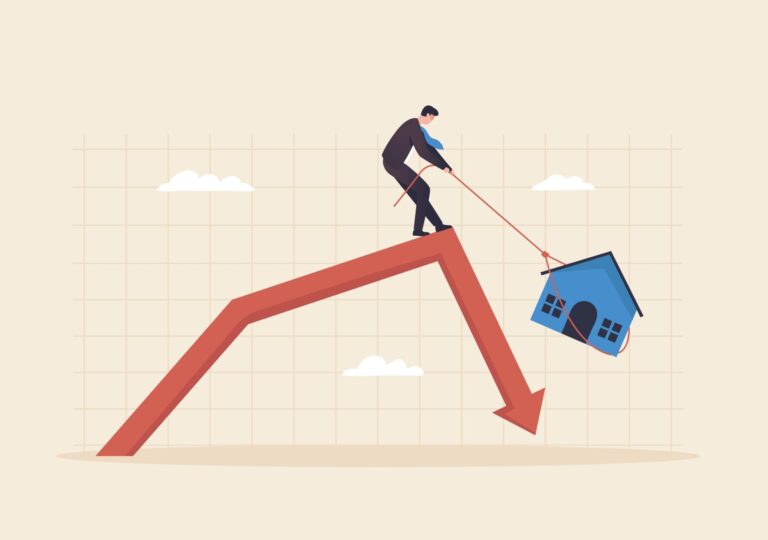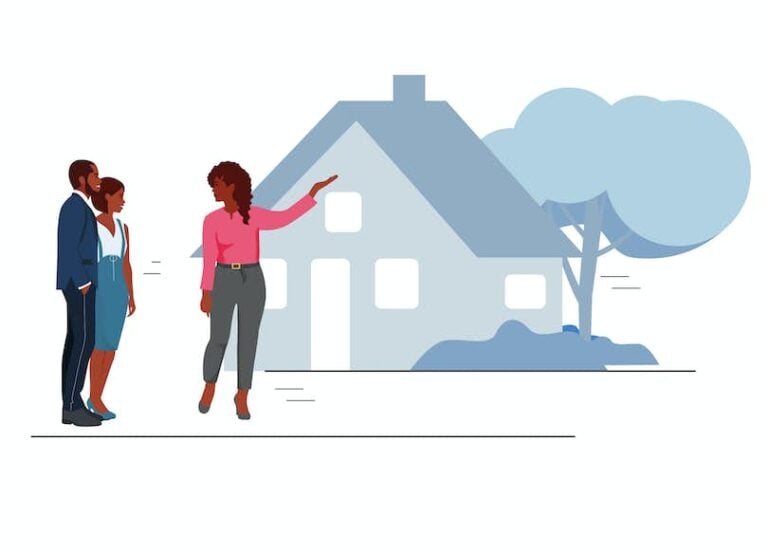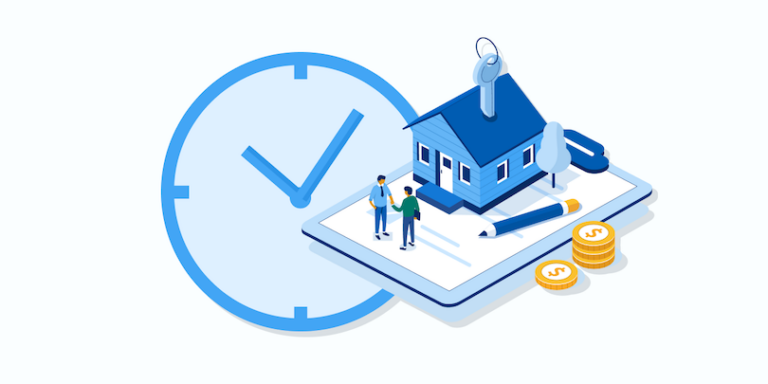
Real Estate Market Statistics | Home-Buying Statistics | Millennial Home Buyer Statistics | Housing Affordability Statistics | Home-Selling Statistics | Renting Statistics | Real Estate Agent and Commission Statistics | Moving Statistics | Real Estate Fun Facts
🏡 What was the real estate market like in 2023? 🏡
The 2023 real estate market was a lousy environment for buyers and sellers. A majority of Americans thought it was a bad time to sell a home (51%) and an even worse time to buy (53%).
The 2023 real estate market was a particularly challenging one. Rising mortgage rates either locked buyers out of homeownership or locked sellers in to their existing low rate, curtailing new home listings and contributing to the U.S. housing shortage.
Today's stalemate in the real estate market is a drastic change from just two years ago, when surging demand caused home sales to reach a 15-year high. Now, sales are down 15% year-over-year, and nobody feels like a winner.
To gauge how Americans are navigating new market realities, Clever Real Estate and its partner websites commissioned a series of surveys and data-driven analyses throughout 2023.
We compiled 65 of the most compelling real estate facts from our research to provide a snapshot of the ever-changing housing market headed in to 2024.
General Real Estate Market Statistics
1. Americans remain surprisingly optimistic about achieving their goals in 2024. Nearly a quarter of millennials (23%) and zoomers (24%) say buying a home is a goal next year, but just 28% of Americans who wanted to buy a home in 2023 actually did.[1]
2. About 83% of non-homeowners want to buy a house but can't because of financial reasons. The top reasons are: They don't have enough for a down payment (53%), homes near them are too expensive (43%), and interest rates are too high (36%).[1]
3. Homes are out of reach for many Americans because home prices have risen more than 2x faster than income since 2000. Since then, home values have soared 162%, while income has increased only 78%. If home prices had grown at the same rate as income since 2000, the median U.S. home would cost nearly $294,000 — about 32% less than today’s price of $433,100.[2]
4. To afford a home today, Americans need an average income of roughly $166,600, but the median household income is just $74,580.[2]
5. The average house-price-to-income ratio in the U.S. is 5.8, more than double the 2.6 experts recommend. None of the 50 most-populous metros in the U.S. have a home-price-to-income ratio that’s equal to or below the recommended 2.6. Pittsburgh has the lowest home-price-to-income ratio at 3.2, while San Jose has the highest at 12.1.[2]
6. As home prices rise, Americans are paying more for less space. Since 1980, the median price per square foot for single-family homes has increased 368% — from $41 to $192. At $133 per square foot, Cleveland is the least expensive city based on the price per square foot, while San Jose is the most expensive at $845 per square foot.[3]
7. Soaring home prices are connected to a surge in homelessness. Metro areas with above-average home values have homeless rates about 2.5x that of metro areas with below-average home values.[4]
Home-Buying Statistics
8. The hot housing market is cooling, but for many beleaguered buyers, the correction hasn't been the boon for which they had hoped. Nearly all recent home buyers (93%) said the real estate market impacted their home-buying experience, compared to 88% in 2022.[5]
9. The percentage of homeowners who said buying a home was more difficult than expected increased from 30% in 2022 to 44% in 2023 because of financial reasons, such as exceeding their budget (45%), high interest rates (42%), and expensive home prices (42%).[5]
10. Nearly 3 in 4 Americans (73%) don’t think homes are affordable right now, but 60% continue to underestimate the median home price. Just 14% actually know the median price ranges between $400,000 and $499,999.[6]
11. Although competition has eased nationwide, a surprising 38% of home buyers still paid more than the asking price for a home in 2023. However, 58% of recent buyers and 63% of first-time buyers admit they overpaid for their home.[5]
12. Mortgage lenders recommend putting down 20% on a home, but 62% of Americans believe it's a requirement. In fact, more than 1 in 5 Americans (21%) said home buyers actually need to put down more than 20%.[6]
13. Nearly 2 in 3 recent buyers (61%) said searching for a home took longer than expected. Three-fourths of buyers (76%) searched for at least one month, while nearly half (47%) looked for at least three months. While house hunting, 95% of Americans made more than one offer.[5]
14. Nearly all recent home buyers (93%) compromised on their priorities, compared to 80% in 2022. Although 1 in 3 buyers (32%) wanted to find an affordable home, it was the most-compromised priority among house hunters. Of those who said it was a priority, about one-third (34%) had to offer a higher price than expected.[5]
15. Compromising on their priorities inevitably led to regret among home buyers. About 93% of home buyers had regrets — up from 72% in 2022. The most common regrets were:
- Buying homes that require too much maintenance (33%)
- Buying too quickly (30%)
- Spending too much (28%)
- An interest rate that's too high (28%)[5]
16. About 88% of homeowners find some aspect of homeownership stressful, and more than one-third (34%) said they'd be less stressed if they didn't own a home. The most stressful aspects of homeownership are maintenance (47%), unexpected expenses (47%), and their current mortgage rate (23%).[7]
Millennial Home Buyer Statistics
17. Millennials are willing to make rash decisions to afford a home in a competitive market, including buying a home sight unseen (90%), offering over asking price (85%), and purchasing a fixer-upper that needs major repairs (65%).[8]
18. Nearly half of millennials (47%) said high interest rates are a significant barrier to homeownership, followed by expensive homes (46%) and saving for a down payment (41%). In fact, 62% of millennial home buyers plan to put down less than 20% on a home.[8]
19. More than half of millennials (54%) have less than $10,000 in savings, including 1 in 5 (20%) who have nothing saved. But nearly 1 in 4 millennials (23%) plan to buy a home that costs more than the national median. To afford such expensive homes, 38% of millennials anticipate maxing out their budget.[8]
20. Millennials are so desperate to own homes that 1 in 7 (14%) would offer $100,000 or more over asking price for their dream home. Meanwhile, not a single boomer would offer that much over asking price.[8]
21. Desperate buyers who rush into a home purchase are more likely to experience financial remorse. About 82% of millennials who own a home have regrets about their purchase. The most common regret among millennial homeowners is that their interest rate is too high (22%).[8]
22. Nearly half of millennials (44%) said they've skipped meals to afford housing payments at some point — more than double the share of baby boomers (20%) who have done the same.[7]
Home Affordability Statistics
23. About 90% of homeowners said some aspect of owning a home is more expensive than they originally expected.[9]
24. On top of their mortgage, the average homeowner in 2023 pays $17,459 annually for additional expenses, including:
- $4,975 for utilities
- $4,283 for maintenance
- $3,890 for home improvements
- $2,795 for property taxes
- $1,516 for homeowners insurance[9]
25. Just 14% of Americans know the true cost of homeownership. The rest are in for a rude awakening. About 1 in 4 Americans (29%) expect to pay less than $5,000 in additional costs every year — 3x less than what the average homeowner actually spends.[9]
26. The cost of owning a home isn't only a matter of money. The average homeowner spends 17.1 hours each month — 205 hours a year — on home repairs and improvements.[9]
27. About 42% of homeowners said they pay for renovations and repairs mostly by borrowing, and 54% of homeowners could not afford a $3,000 emergency repair without going into credit card debt.[9]
28. More than half of homeowners (57%) would have approached buying a house differently had they realized the true cost of homeownership:
- 42% would have purchased a home that requires less maintenance.
- 33% would have negotiated a better price or contingencies on their home.
- 29% would have purchased a less expensive home.[9]
29. More than half of home buyers (56%) have felt in over their head financially since purchasing their home, and almost two-thirds (62%) have struggled to make mortgage payments on time. While paying for their home, about half of home buyers (56%) have taken on additional debt to maintain their lifestyle.[5]
Home-Selling Statistics
30. The extreme seller's market has cooled as high mortgage rates and expensive home prices suppress buyer demand. As a result, 40% of recent sellers said selling their home was more difficult than they expected — up from 31% in 2022. Unexpected difficulties inevitably led to more stress, with 56% saying the home-selling experience was stressful.[5]
31. Today's sellers have to compromise to make deals happen, but doing so often leads to regret. About 95% of home sellers have regrets — up from 90% in 2022. The most common regrets are paying too much in realtor fees (28%), making too many concessions (26%), and having their home sit on the market too long (21%).[5]
32. The percentage of homes that sold within one month decreased by half — from 55% in 2022 to 28% in 2023 — indicating a cooling market.[5]
33. More than half of home sellers (58%) said earning the most money from their home sale was very important, but 38% weren't satisfied with the profit they made on their sale.[10] A majority of sellers (57%) made less than $50,000 on their home sale, and 1 in 14 (7%) actually lost money or broke even.[5]
34. Just over half of sellers (53%) had to reduce the asking price for their home. About 45% of home sellers rejected an offer, only to settle for a lower price later on.[10]
Renting Statistics
35. The U.S. defines affordable housing as housing that costs no more than 30% of an occupant's gross monthly income, but about 1 in 4 renters (24%) said they spend half their income or more on housing.[11]
36. Renters must spend a greater share of their income on housing than in previous years because rent has outpaced income by 7% over the past four decades. Since 1985, the monthly median rent price in the U.S. has increased 208% — from $378 to $1,163 in 2021 — the last full year for which rent and income data are available.[12]
37. From 2009 to 2021, rent growth outpaced income growth in 46 of the 50 most-populous metros. Rent exceeded income by the largest margin in Denver (71%) and the smallest margin in Milwaukee (5.2%). Income growth has exceeded rent growth in only four U.S. cities: Providence, Buffalo, Cleveland, and Pittsburgh.[12]
38. The rent-to-income ratio is the percentage of income a tenant will need to afford monthly rent. Miami has the highest rent-to-income ratio at 28.5%, while Cincinnati has the lowest at 15.5%.[12]
39. About 84% of renters are stressed about not owning a home, but it is cheaper to rent than buy in 45 of the 50 most-populous U.S. cities based on the price-to-rent ratio, which is calculated by dividing the median home price by the median annual rent.[7][13]
40. A price-to-rent ratio of 15 or less means it’s better to buy. A price-to-rent ratio of 21 or more means it’s better to rent. With the lowest price-to-rent ratio (12) and the lowest home prices ($188,418), Pittsburgh is the best city for buying a home. With the highest price-to-rent ratio (38) and the highest home prices ($1.4 million), it's demonstrably easier to rent than buy in San Jose. Unfortunately, the typical monthly rent in San Jose is still $3,181 — nearly 3x more than Pittsburgh’s monthly rent of $1,214.[13]
41. Nationally, the average monthly mortgage payment is $174 more than the average rent payment. It would take nearly 215 months of rent to buy an average-priced U.S. home — almost 18 years’ worth of rent.[13]
42. Homeownership is still a goal for 85% of renters, but 72% said they'll never have enough money to buy one. Some renters are so desperate to own homes that 31% would sell their own plasma, and 29% would skip meals. With no realistic way to afford a home, 66% of renters said home prices make them feel hopeless.[11]
Real Estate Agent and Commission Statistics
43. About 79% of Americans who sold a home in 2022 or 2023 used a real estate agent. Of the 21% who did not use an agent, 20% sold to a cash buyer or investor, 13% sold to an iBuyer, and 13% listed their home for sale by owner. However, 53% of non-traditional home sellers wish they used a traditional real estate agent.[10]
44. Home sellers who used an agent averaged $46,603 more in profit than those who didn't use an agent. In fact, those who sold without a realtor were 3x more likely to say they lost money on their home sale than those who sold with a realtor.[10]
45. Working with a real estate agent has many advantages, but it comes at a cost. The No. 1 regret among home sellers was that their agent's commission rate was too high. The percentage of respondents who cited this as their top regret surged 40% in just a year, from 20% in 2022 to 28% in 2023.[5]
46. Nearly half of 2022 and 2023 home sellers (48%) said avoiding high commission was a “very important” priority when selling their home, and 42% said they were less likely to work with agents who were unwilling to negotiate commission.[10]
47. More than half of Americans (51%) underestimate how much they’ll pay in realtor commission. Only 11% know agents earn about 6% of the final sale price.[6]
48. Home sellers usually pay commission for their agent and the buyer's agent, but they are becoming increasingly fed up with the traditional commission model. About 55% of sellers said they shouldn’t be obligated to pay the buyer’s agent’s half, and a recent lawsuit aims to release them from that responsibility.[10] About 62% of Americans already think buyers pay their agent’s commission. This misunderstanding could be why 65% of Americans wrongly think buyers can save money by not working with a real estate agent.[6]
Moving Statistics
49. Americans said the most desirable places to live have a low crime rate (46%), affordable homes (43%), and a low cost of living (41%), but they rank California as the best state to live, followed by Florida and New York — three expensive states. The most undesirable states are Alaska, Alabama, and California.[14]
50. Americans consider Seattle the most desirable city in the U.S. The least desirable city is Washington, D.C.[14]
51. Cities and states that Americans think are desirable don’t necessarily attract the most new residents. In the first six months of 2023, South Carolina had more inbound moves than any other state, while Illinois had the most outbound moves, according to Allied Van Lines. It's no surprise, then, that Chicago had more outbound moves than any other city, while Phoenix had the most inbound moves during that same time period.[14]
52. Just 63% of Americans like where they live in 2023 — down from 80% in 2022. But of those who don’t like where they live, 42% said they can’t afford to move.[14]
53. About 1 in 4 Americans (26%) hire movers, but 46% were surprised by the cost. Roughly 40% of Americans did not budget their move correctly, with 17% reporting that their move was ultimately too expensive.[15]
54. A majority of Americans spent less than $2,000 on their moves (54%), while 46% spent more than $2,000 — including 7% who spent $5,000 or more. Sixty percent of those who used a moving service spent more than $2,000, whereas only 46% of all respondents reported spending that much. Americans who made long-distance moves paid the price as well, with 60% spending $2,000 or more.[15]
55. Three-fourths of Americans (75%) have regrets about their move, including 28% who regret not hiring movers — despite the cost.[15]
56. Spending money on movers is worth the convenience for some Americans. About 43% said working with movers is easier, and 40% said it saves time. Only 56% of Americans who hired a moving company said the moving process was stressful, compared to 68% who did not use a mover.[15]
57. Still, a whopping 44% of Americans cried at least once during the moving process, and 43% fought with loved ones.[15]
Real Estate Fun Facts
The post-pandemic housing market has been anything but normal. These eight peculiar facts offer a unique perspective on the weirdest real estate market ever.
Haunted Real Estate
58. About 29% of Americans believe they’ve lived in a real haunted house — up slightly from 24% who said the same in 2022. Of those who have lived in a haunted house, 27% knew the house was haunted before they moved in and still chose to live there. However, more than 1 in 3 haunted homeowners (36%) regret living in a haunted house, and 55% would not buy another home they knew was haunted.[16]
59. In this monster of a market, buyers are willing to overlook just about anything to own a home, including a few ghosts. About 71% of Americans could be convinced to buy a haunted house to save money.[16]
60. Ghosts are scary, but 93% of Americans are more afraid of home repair problems, such as mold (60%), termites (57%), and a leaky roof (54%).[16]
61. Nearly half of Americans (48%) would rather live with ghosts than purchase a home near a nuclear waste facility.[16]
Cannabis and Home Values
62. Recreational cannabis is legal in 23 states and Washington, D.C. Those jurisdictions have seen property values rise by $185,075 since 2014, compared to $136,092 in states without recreational cannabis. That means home values climbed an average of $48,983 more in states with recreational cannabis than in states without recreational cannabis.[17]
63. Medicinal cannabis is also associated with higher increases in home values. Since 2014, states with medicinal cannabis have seen home values increase $29,289 more than in states without medicinal cannabis.[17]
64. There’s a notion that dispensaries hurt property values, but the data shows that since 2014, home values increased $67,359 more in cities with recreational dispensaries than in cities where recreational marijuana is legal but dispensaries are not available.[17]
65. In states with legal recreational cannabis, weed sales in 2023 are projected to generate about $25 billion in overall sales revenue — mostly collected as taxes. That's more than $1 billion per legal state.[17]
About Clever
Since 2017, Clever Real Estate has been on a mission to make selling or buying a home easier and more affordable for everyone. 12 million annual readers rely on Clever's library of educational content and data-driven research to make smarter real estate decisions—and to date, Clever has helped consumers save more than $160 million on realtor fees. Clever's research has been featured in The New York Times, Business Insider, Inman, Housing Wire, and many more.






